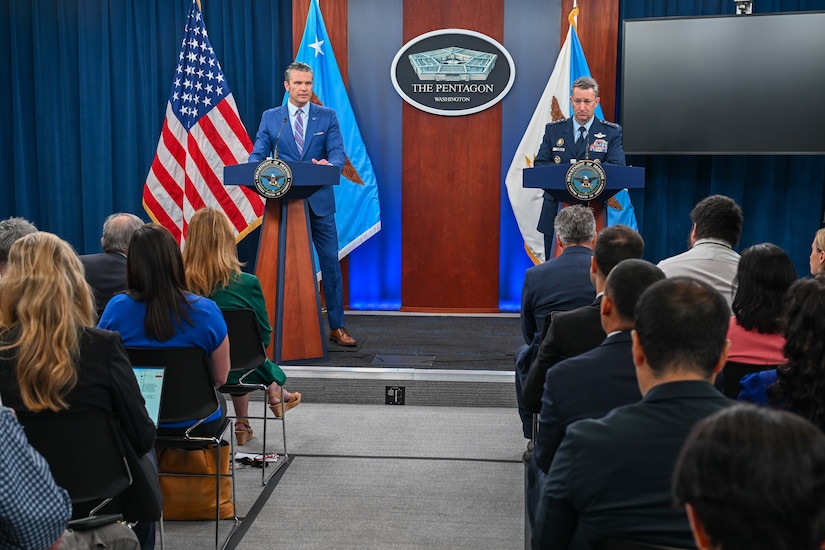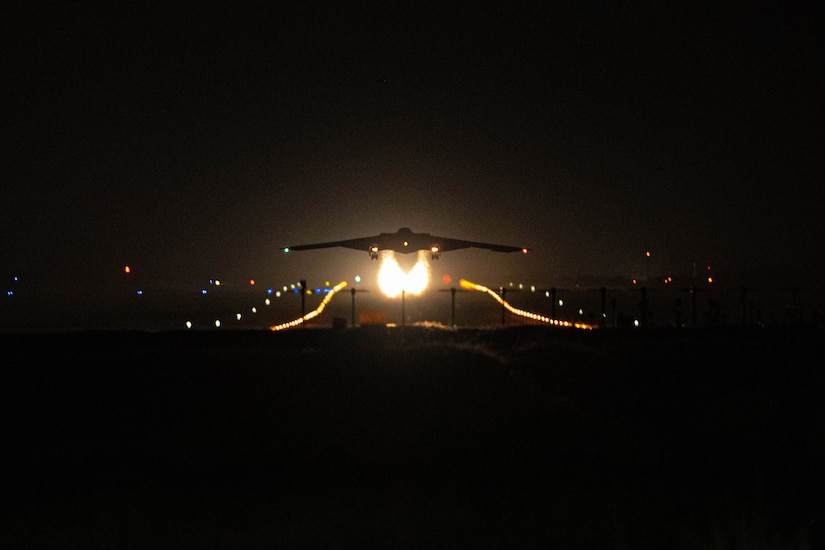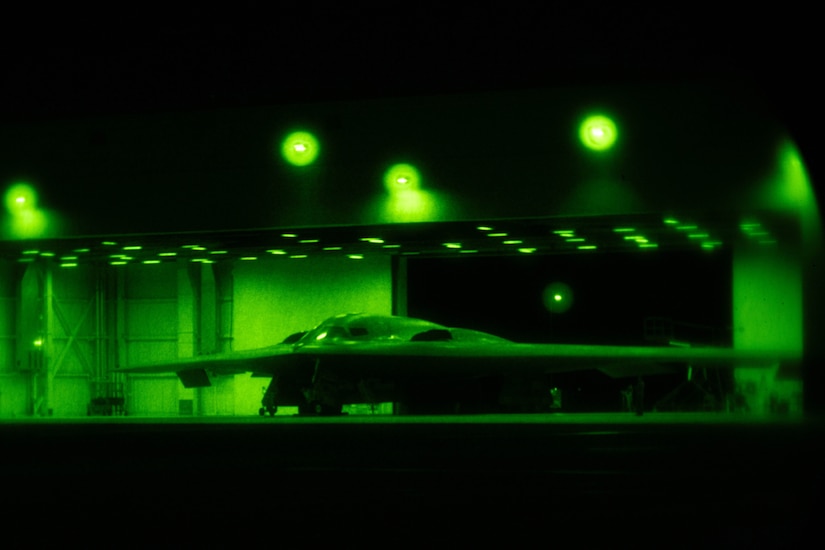
by C. Todd Lopez at U.S. Department of Defense
This weekend’s strike on Iran’s Fordow Fuel Enrichment Plant used 30,000-pound GBU-57 “massive ordnance penetrator” bombs. The design of those weapons and plans for attacking the site had been in the works for some 15 years, which resulted in the destruction of Iran’s nuclear capabilities.

“President Donald J. Trump directed the most complex and secretive military operation in history, and it was a resounding success, resulting in a cease-fire agreement and the end of the 12-day war [between Iran and Israel],” said Defense Secretary Pete Hegseth during a press briefing today at the Pentagon. “Because of decisive military action, President Trump created the conditions to end the war, [while also] decimating — choose your word — obliterating, destroying, Iran’s nuclear capabilities.”
Air Force Gen. Dan Caine, chairman of the Joint Chiefs of Staff, said two officers at the Defense Threat Reduction Agency had studied the site in Iran, which was built to enrich uranium for use in nuclear weapons.
The Defense Threat Reduction Agency, Caine said, is the world’s leading expert on underground targets — such as the Fordow site, which is about 60 miles south of Tehran.
“In 2009, a [DTRA] officer was brought into a vault at an undisclosed location and briefed on something going on in Iran,” Caine said. “He was shown some photos and some highly classified intelligence of what looked like a major construction project in the mountains of Iran. He was tasked to study this facility, work with the intelligence community to understand it, and he was soon joined by an additional teammate.”
The two worked for 15 years to gain an understating of the site, but came to realize, after studying the location, that the United States didn’t have a weapon that could penetrate into its depths to destroy what was contained inside.
“They began a journey to work with industry and other tacticians to develop the GBU-57,” Caine said. “They tested it over and over again, tried different options, tried more after that — they accomplished hundreds of test shots and dropped many full-scale weapons against extremely realistic targets, for a single purpose: kill this target at the time and place of our nation’s choosing.”
As part of Operation Midnight Hammer, directed by the president, on June 21, at 6:45 p.m., which is Sunday, June 22, at 2:15 a.m. in Iran, U.S. B-2 Spirit bombers out of Whiteman Air Force Base, Missouri, dropped 14 of those GBU-57 bombs onto Fordow and a second nuclear facility, destroying the facilities and setting back Iranian nuclear efforts by years.
While Caine said the joint force doesn’t do battle damage assessment — the intelligence community does — he was able to relay what’s known so far.
The weapons were built, tested and delivered properly; they were released on-speed and on-parameter; they were all guided to their intended targets; and the weapons all functioned as designed, he said.
“We know that the trailing jets saw the first weapons function, and the pilot stated, ‘this was the brightest explosion that I’ve ever seen. It literally looked like daylight,'” Caine said.
It wasn’t just hardware and experts at DTRA who made Midnight Hammer hit as hard as it did. The crews who flew non-stop for 36 hours and more than 13,000 miles round trip, also played a huge role, Caine said.
The B-2 teams included both active-duty and Missouri National Guard pilots, Caine said.
“When the crews went to work on Friday, they kissed their loved ones goodbye — not knowing when or if they’d be home,” Caine said. “Late on Saturday night, their families became aware of what was happening, and on Sunday, when those jets returned [to] Whiteman, their families were there — flags flying and tears flowing. I have chills literally talking about this.”
Operation Midnight Hammer was a success, Caine said, because of the bomber crews, experts at DTRA and thousands of scientists, airmen and maintainers working together.
“[This] … is what America’s joint force does,” Caine said. “We think, we develop, we train, we rehearse, we test, we evaluate, every single day. And when the call comes to deliver, we do so. I could not be more proud standing up here today of our joint force.”
At the conclusion of Operation Midnight Hammer, Caine said, the joint force did not stand down. Instead, it continues to defend the United States.
Following the destruction of the Iranian uranium enrichment site, Caine said, Iranians attacked American forces at nearby Al Udeid Air Base in Qatar. And there, the joint force defended as it was trained to do.
On Monday morning, Caine said, the joint force saw indications that Iran meant to attack U.S. bases in the U.S. Central Command area of responsibility. At Al Udeid, he said, most forces were moved off base to extend the security perimeter, but two Patriot missile batteries remained behind to defend the installation.
“[That’s] roughly 44 American soldiers responsible for defending the entire base, to include Centcom’s forward headquarters in the Middle East, an entire air base and all the U.S. forces there,” Caine said. “The oldest soldier was a 28-year-old captain. The youngest was a 21-year-old private who’d been in the military for less than two years.”
Around 12:30 p.m. Monday, or 7:30 p.m. in Qatar, Caine said, Iran attacked.
“As the targets were detected, round after round of Patriot missiles are ejected from their canisters by an initial launch charge,” he said. “Then the main solid rocket motor ignites — you can feel this in your body if you’ve ever been around a Patriot taking a shot. And round after round goes out and guides against those missiles coming inbound. We believe that this is the largest single Patriot engagement in U.S. military history.”
Caine said the U.S. military was joined in protecting the installation by Qatari Patriot crews. While Caine wouldn’t say how many Patriot missiles were launched, he did say there was “a lot of metal flying around.”
“Between attacking missiles being hit by Patriots, boosters from attacking missiles being hit by Patriots, the Patriots themselves flying around, and the debris from those Patriots hitting the ground, there was a lot of metal flying around,” he said. “Our U.S. air defenders had only seconds to make complex decisions with strategic impact. These awesome humans, along with their Qatari brothers and sisters in arms, stood between a salvo of Iranian missiles and the safety of Al Udeid. They are the unsung heroes of the 21st century United States Army.”
Following execution of Operation Midnight Hammer, and its follow-on effects, Hegseth said the effects are worth remembering.
“This was an historically successful attack, and we should celebrate it as Americans,” the secretary said. “It gives us a chance to have peace, a chance to have a deal, an opportunity to prevent a nuclear Iran — which is something President Trump talked about for 20 years.”
# # #
Continue Reading


